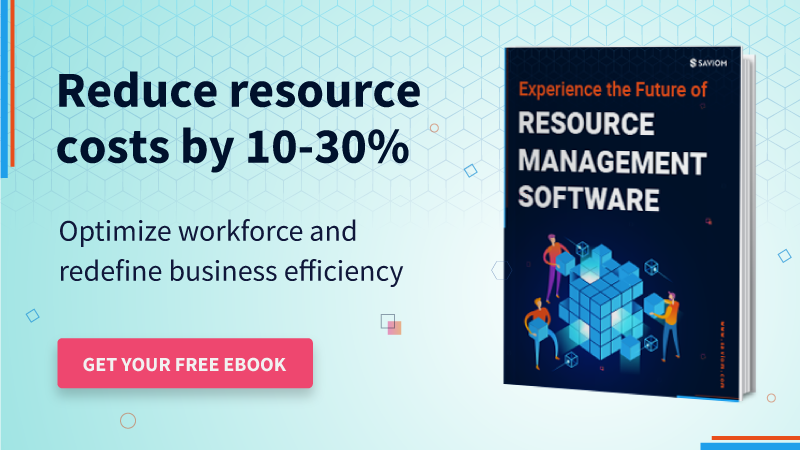Human Resources are the most expensive assets, and therefore, organizations must utilize their workforce efficiently and effectively. One of the best practices is to regularly monitor and improve their performance.
However, employee performance can deteriorate due to a lack of clarity in job description, wrongful hiring, over/under allocation of work, etc. These results in further ramifications like project failures, time and cost overruns, and more.
Since employee performance directly impacts a firm’s ROI, it is essential to identify the root cause of their underperformance, if any, and constantly take suitable measures to boost their efficiency.
This blog introduces the practices to follow to bring out the best in your employees and boost their productivity. To begin with, let’s first define:
What is Employee Performance?
Employee performance means determining how efficiently employees fulfill their job roles, complete allocated tasks, interact, and collaborate with others. Broadly speaking, employee performance comprises primarily four factors: quality, quantity, effectiveness, and work ethics. For an individual employee, performance may refer to the efficiency and quality of the role-specific tasks.
Let’s consider the example of a sales executive’s performance. It primarily means meeting the sales targets in a stipulated period of time. The closer the sales figures are to the set sales targets, the better the performance is. Similarly, a customer support executive’s performance may refer to the number of daily queries they resolve successfully in a given evaluation period.
Read More: Resource Allocation: A Guide on How to Apply it to Project Management
Best Ways to Improve Employee Performance at Work
Since performance improvement is subjective, the exact strategy to implement can be unique to every enterprise based on its organizational structure and objectives. However, some common ideas and practices that can help you ace it are as follows.
Ensure Complete 360-Degree Work Visibility
Absolute work visibility helps you stay informed of the projects and resources allocated to them. Thus, managers can implement a resource management tool and consolidate all resource-related information on a centralized platform. Using the tool, managers can seamlessly keep track of the number of projects running at a time and resources across different departments engaged in them.
Moreover, people-on-the-bench reports help foresee the resources likely to end up on the bench soon. You can leverage valuable insights from these reports and proactively find suitable tasks to assign resources to before they hit the bench. This way, you can manage the bench effectively, keep them profitably engaged, and upkeep their productivity all the time.
Allocate Competent Resources to Suitable Tasks
The requirements of skills sets and expertise differ from project to project. If you allocate a less experienced employee to a high-level skill-intensive task, it can become overwhelming and hamper their performance and morale. On the contrary, assigning a skilled resource to a basic task leads to unnecessary budget overruns and lower engagement. All these factors cumulatively decline their performance and productivity.
Thus, to avoid this predicament and ensure optimum performance output, managers can use a resource management tool to get insights into available skillsets within the resource pool. Then, using appropriate filters, they can identify resources matching the qualification, skills, experience, cost, and availability before allocating them to the project.
Read More: Resource Allocation: A Guide on How to Apply it to Project Management
Enable Employees to Select Projects Suiting their Interests
It often happens that managers fail to consider resources’ interests while assigning them to projects. Consequently, it results in a decline in their engagement levels and a dip in their productivity. It can even lead to unplanned attritions if not checked at the right time. To fulfill the project resource requirements, the concerned resource manager can publish open positions which notify all personnel matching the desired criteria.
Accordingly, resources can show interest and apply for those open positions. The resource manager screens all the applications and picks the best-fit resources for the projects.
When resources get the work that interests them, it increases their task ownership and engagement, thereby enhancing their performance.
This way, it creates a win-win situation for both employees and managers.
Set Clear Goals and Expectations Right at the Start
No matter how skilled and competent your employees are, they can give their best only when they know what’s expected from them. If resources are unsure of how they are contributing to the firm’s success, they might exhibit less engagement and will lose the sense of purpose. Therefore, it is imperative for managers to lay down goals and expectations with utmost clarity.
Besides enumerating key responsibility areas (KRAs), convey project-specific goals, revenue targets, and milestones beforehand. It eliminates any conflicts in the minds of resources engaged in a project and provides a clear understanding of objectives. Accordingly, they can align their efforts with the project’s end goals right from the beginning and work with all their might to seal its success.
Monitor and Manage Employees’ Performance in Real-Time
Tracking and monitoring resources’ performance is the key to keeping your business on track and driving efficiency. You can assess their performance using tangible metrics like resource utilization. So, using a resource management tool, managers can get precise data-driven insights in real-time. You can also compare the actual time they spend on tasks with the schedule you set for them using the forecast vs. actual reports.
If you encounter instances where employees take more time than expected to accomplish a task, you can communicate with your resources. You can, then, find bottlenecks and eliminate them to optimize your workforce’s output. In cases where actual task completion time is less than the forecasted time, you can reassign that resource to other tasks to utilize them completely and maximize their performance.
Read More: How to Track Resource Utilization?
Regularize Communication to Foster a Conducive Environment
A recent survey shows that effective communication improves productivity by as much as 25 percent.
It is, therefore, important to ensure timely communication with resources and stay abreast of their progress at any time. Regularized communication helps employees stay connected with their team members and synchronize their efforts towards the common goals. With complete knowledge of project interdependencies, they know how their work will influence the overall project. Thus, it fills them with a sense of purpose and responsibility to develop a synergy with others and achieve high-quality deliverables
Besides, you can also have one-on-one feedback meetings on a timely basis to discuss their performance and give your inputs. At the same time, it is vital to keep your communication two-way during meetings to let them freely share their genuine concerns and roadblocks. Then, based on their feedback, you can formulate a best-fit plan to eliminate these obstacles and provide them with a conducive environment to perform better.
Read More: 11 Ways to Improve Cross-Departmental Collaboration
Emphasize a Sense of Accountability and Ownership in Employees
No matter how small or big an organization is, compliance with work culture and practices is crucial. While constructive feedback accompanied by an amicable approach helps, there’s also a need to affirm authority at times. Give your resources an honest review of their performance and areas where they need significant improvements.
Hold your employees accountable for what they do and ask them to assume ownership of every task and failure. If you notice a constant decline in performance, consider devising a performance improvement plan for the employee. Make sure that they follow it religiously to improve their professional acumen and are well-informed of the impact of failing to meet expectations.
Acknowledge and Reward Good Work
Gallup observes that only one out of three employees receive praise for good performance. The ones who don’t are twice as likely to leave the organization. Hence, it is important to acknowledge and reward your resources’ good work. So, managers must organize rewards and recognition programs at regular intervals to appreciate good work and exceptional performance.
When you reward high-performers – especially in public, they feel elated and valued. It also boosts employee engagement and inspires them to work better to contribute to the company’s growth. The rewards can be monetary, non-monetary, or a mix of both. For instance, you can reward high-performing employees with bonuses, small prizes, and even promotions on a case-to-case basis. Furthermore, the ones who aren’t rewarded will improve further and enhance their performance to cross these benchmarks.
Read More: Employee Recognition Programs: Types, Benefits and Best Practices
Build a Personalized Training and Development Plan for Resources
Every employee has their own strengths, shortcomings, goals, and aspirations. Hence, personalizing a training and development plan for your resources is a wise idea. An individual development program (IDP) lets you set the stage for effective learning and utilizing gained knowledge to supplement the organization’s growth. Gain insights into the individual employees’ performance and find areas where they need learning and upskilling.
Segregate your resources in different bands of competencies into different groups based on training requirements and preferences. Once it’s done, create each group’s employee development plan. Alongside, provide your resources with real-life scenarios and situations to test the knowledge they’ve gained. It will help you get a clear picture of where they stand and optimize your employee development program if needed.
Conclusion
Enhanced employee performance benefits both an organization and its resources in the long run. It lets firms maintain a competitive edge while allowing employees to grow and excel on the professional front. Thus, formulating an effective performance management strategy is imperative.
Even though every company adopts approaches to improve performance based on its organizational framework, integrating a resource management tool will make them more efficient. Overall, following the above-mentioned best practices to improve performance will allow employers to unleash the maximum potential of their workforce.
What does your performance management strategy look like?
The SAVIOM Solution
SAVIOM has over 20 years of experience helping multinational clients manage their resources efficiently and effectively. With over 20 years of experience, this Australian-based MNC has a global presence across 50 countries and has helped 100+ clients meet their specific business goals. Saviom also provides tools for project portfolio management, professional service automation, and workforce planning software. So, SAVIOM can help your business to establish an efficient system geared towards your specific business challenges.












